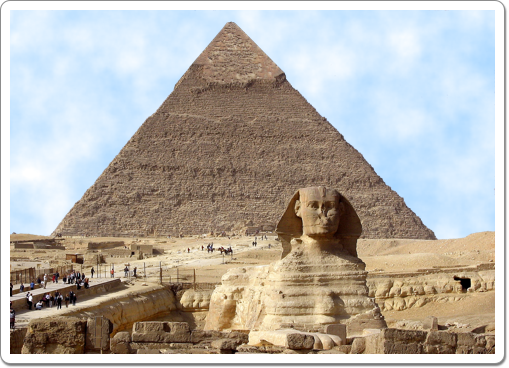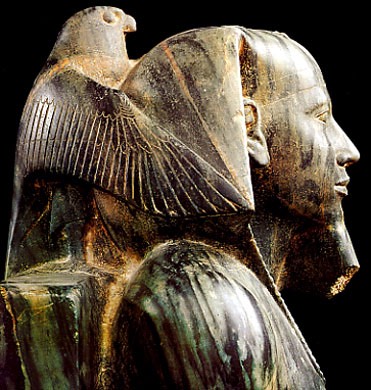
Khefren's pyramid at Giza, with the Great Sphinx in the foreground.
Location
After Kheops, Khefren was the second king to choose Giza as the location for his funerary monument. Kheops' eldest surviving son and immediate successor, Djedefre, had not followed in his father's footsteps and moved away from Giza to the more mountainous area of Abu Rawash, some 8 km to the North, thereby establishing the Northernmost part of the Memphite necropolis.
The reasons for Djedefre's move north and Khefren's return are not known. Theories about this being the result of some dynastic feuds are, no matter how romantic they may sound, mere speculation. Practical or religious considerations may as easily have been the reason behind both the move away from Giza as the move back.
Whatever the motivation of both Djedefre and his brother Khefren, the latter built his pyramid at some distance to the Northwest of his father's at Giza. The diagonal of Khefren's pyramid is an almost perfect continuation of the diagonal of Kheops', a tribute to the craftsmanship of the architects and builders of the monument.Although Khefren's pyramid appears to be taller than Kheops', it is, actually, some 3 metres smaller. Its taller appearance is the result of the fact that it was built on a higher plateau than the pyramid of Kheops.
Structure
The pyramid complex of Khefren shows a further evolution in the structure of this type of monument. A Valley Temple in the East, located right next to an artificial lake, was connected to the actual mortuary temple by a covered causeway.
Judging by its size, the mortuary temple appears to have gained in prominence. The structures East of the pyramids of Snofru at Dashur, were nothing more but chapels. With Kheops, these chapels were extended into a small temple, but it was with Khefren's mortuary temple that most of the elements that would later become traditional were incorporated into the edifice.
A small Satellite Pyramid is located to the South of the king's main pyramid. No Queens' Pyramids appear to have been built.

Hover over or tap the map of Khefren's Pyramid Complex at Giza and click or tap on the little circles on the map to learn more about the different architectural elements that made up this complex.
Source: Lehner, Complete Pyramids, p. 124.
The Sphinx and its temple, located North of the causeway and Valley Temple respectively, may also have played an important part in the funerary cult of the deceased king.
Click on the thumbnails below to learn more about Khefren' funerary complex.
